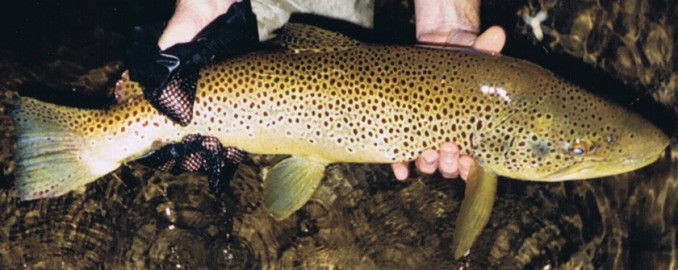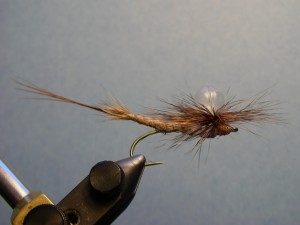
Hex fishing at night can be difficult for some just to know where the fly is, let alone if it’s on target and drifting drag- free to rising fish. Glow-in-the-dark fly lines help with their non-intruding glow characteristics, but that doesn’t show you your fly at the end of the leader, where it’s at and whether or not the fish just ate your hex or a natural bug nearby.
The “Thing-a-ma-Hex” uses a miniature, glow-in-the-dark strike indicator (expensive word for bobber) designed to be the post while helping you to keep track of the fly once its on the water. This glowing post also helps to keep the fly landing upright and floating on the water.
Charge the uni-bobber with a bright flashlight being careful not to shine 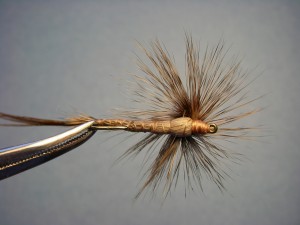 the light on the water and fish you are targeting – that assuredly will put them down. The amount of glow is very subtle, so it doesn’t spook fish while providing an idea of where the fly is located on the water.
the light on the water and fish you are targeting – that assuredly will put them down. The amount of glow is very subtle, so it doesn’t spook fish while providing an idea of where the fly is located on the water.
If you are looking for a bright beacon, this is not it. You will want to dress this hex fly with floatant beforehand, and as with any dry fly, keep it out of the water until you are ready to cast. Have fun tying and good luck hex fishing!
Thing-a-ma-Hex Recipe
Hook: TMC 2313 #6
Thread: Flymaster Plus – Brown
Tail: Pheasant Tail
Body: Deer Hair
Hackle: Brown & Grizzly Rooster Neck or Saddle
Post: Uni-Bobber – Glow-In-The-Dark
Tying Instructions
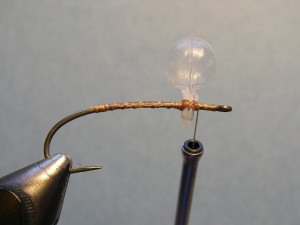 Step 1. Put the hook in the vise and wrap a base layer of thread from behind the eye to above the
Step 1. Put the hook in the vise and wrap a base layer of thread from behind the eye to above the
hook point. Slip the uni-bobber over the eye of the hook about ¼ inch behind the eye and attach to
the hook with figure-8 wraps so it is upright. Make enough wraps and tight enough to keep it there.
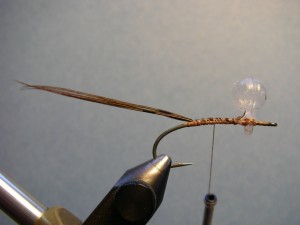 Step 2. Trim off a 4-5 pheasant tails fibers and tie in behind
Step 2. Trim off a 4-5 pheasant tails fibers and tie in behind
the uni-bobber so the tips extend 1½ times the hook shank.
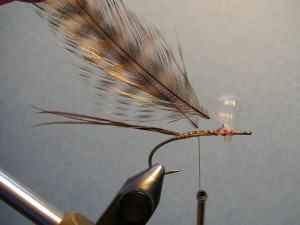 Step 3. Select two large hackle feathers. Trim some of the barbs to stubs at the
Step 3. Select two large hackle feathers. Trim some of the barbs to stubs at the
base of the feather to provide some grip and prevent the feather from slipping out.
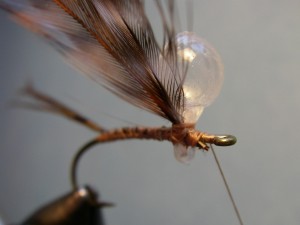 Step 4. Tie in at the base of the uni-bobber with the underside/convex side of the
Step 4. Tie in at the base of the uni-bobber with the underside/convex side of the
feather facing you. After tying in, wrap horizontally up the base of the uni-bobber.
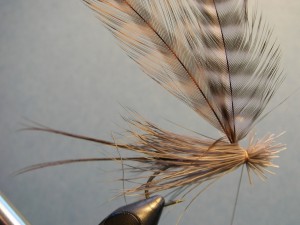 Step 5. Select a long clump of deer hair that is at approximately the diameter of a
Step 5. Select a long clump of deer hair that is at approximately the diameter of a
pencil. Clean the under-fur and short hairs, then use a hair stacker to even it. Pull out by the
base of the hair and remove the short hairs, while trying to get the proper thickness for the
body which should be aprox. 2/3 of a pencil’s diameter. Tie in the deer hair between the
uni-bobber and hook eye so the tips extends beyond the hook half the length of the shank.
The pheasant tail fibers should extend beyond the tips making for a tail.
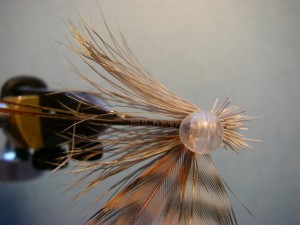 Step 6. Even the hair so it is on both sides of the hook shank.
Step 6. Even the hair so it is on both sides of the hook shank.
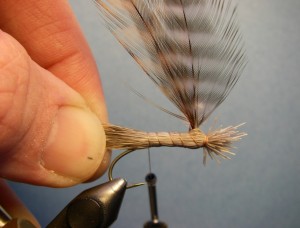 Step 7. Gently wrap the thread backwards while holding the extended deer hair
Step 7. Gently wrap the thread backwards while holding the extended deer hair
with your opposite hand. Make for even spaced wraps falling ¼” from the tips.
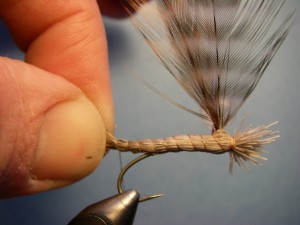 Step 8. At the end, make two or three wraps a little more pressure, then advance the thread forward
Step 8. At the end, make two or three wraps a little more pressure, then advance the thread forward
again with increased pressure, crisscrossing the wraps and ending between the uni-bobber and hook eye.
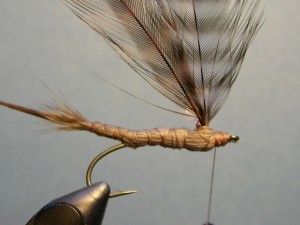 Step 9. Trim the butts of the deer hair and tie down the head covering any deer hair that is exposed.
Step 9. Trim the butts of the deer hair and tie down the head covering any deer hair that is exposed.
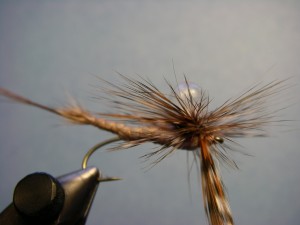 Step 10. Take both the feathers at the same time and wrap them under the bulbous uni-bobber
Step 10. Take both the feathers at the same time and wrap them under the bulbous uni-bobber
and make a heavy parachute style hackle. Tie off and whip finish. Be sure to out head cement
on both the head of the fly and the wraps at the end of the extended body.
 The end result!
The end result!
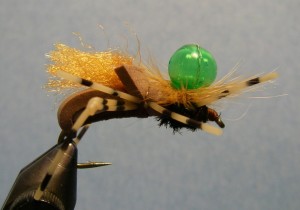 The idea for this fly was borrowed from a fly called a Thing-A-Ma-Bug which uses non-glow in the dark
The idea for this fly was borrowed from a fly called a Thing-A-Ma-Bug which uses non-glow in the dark
uni-bobbers as the post to assist with floatation and easy identification on the water.
